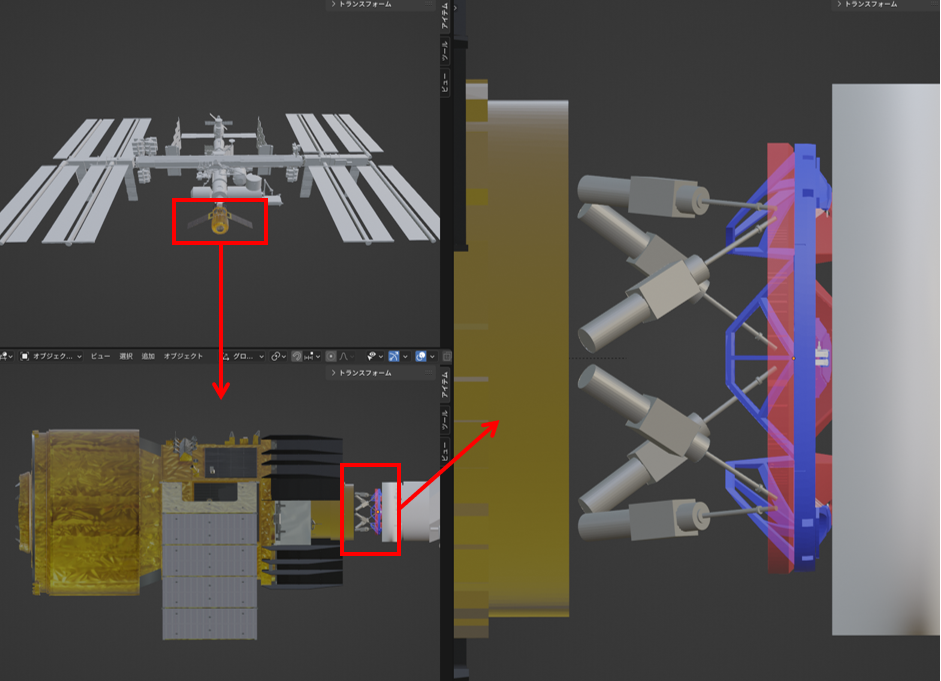Research of model based development for space systems at early development phase
JAXA Supercomputer System Annual Report February 2022-January 2023
Report Number: R22EDG20177
Subject Category: Research and Development
- Responsible Representative: Taro Shimizu, Research and Development Directorate, Research Unit III
- Contact Information: Hikaru Mizuno , Research Unit III, Research and Development Directorate. Japan Aerospace Exploration Agency(mizuno.hikaru@jaxa.jp)
- Members: Kaname Kawatsu, Hirofumi Kurata, Hikaru Mizuno
Abstract
Recently, there are many research with regard to model-based development(MBD) approach and digitalization of space systems. JAXA Reserch Unit III is developing system simulator necessary for space system design in early phase, and it can be used to improve efficiency of development time. In this project, we will develop a method to run various MATLAB/Python/C-based simulation effectively in the concept study phase ,especially large simulations such as parameter studies and Monte Carlo simulations, on JSS3.
Reference URL
N/A
Reasons and benefits of using JAXA Supercomputer System
All JAXA employee can use JSS quickly and easily without any complicated procedures.
The system can be connected within the JAXA intranet, so there is little risk of information leakage.
Quick access to extensive support on how to use the system.
Linux container technology can be applied.
Achievements of the Year
Results.1)
In the development of the HTV-X automated docking mechanism, a mechanism to efficiently perform parameter studies of the docking mechanism control parameters was established and applied using JSS3. For the on-orbit demonstration of automatic docking, it is necessary to guarantee that the loads and moments generated during docking are less than the specified values under various docking conditions (speed, attitude, etc.). To achieve this, it is necessary to set appropriate values for the parameters of the control controller for automated docking.
In this study, we utilized NASA-Trick, a docking simulator used by NASA, to simulate all possible docking conditions on the Trick on a computer, which enabled us to perform a parameter study of automated docking prior to the actual docking test.
Specifically, NASA-Trick was converted to a Docker container, which was then converted to a Singularity container on the JSS3 side, and a framework was developed to run the Trick simulation in parallel in a batch job. This made it possible to run a maximum of 400 parallel simulations, and JSS3 TOKI-RURI was able to complete about 800,000 cases of parameter study calculations in 1.5 months.
Results.2)
In the development of the “Concurrent Design Platform” (CDP), a platform for performing system engineering at an early stage of development, which is being jointly developed by the Systems Technology Unit and Research Unit 3, there is a need to execute MATLAB-based simulations of trajectory, power, heat, communication, etc. on JSS3. We have developed a framework for continuous execution of CDP simulations by utilizing the technology for executing MATLAB-based simulation models on JSS3, which was a development result of JSS in FY21.
In particular, we were able to create Docker containers for MATLAB-based simulations of orbit, power, heat, communication, etc., convert them to Singularity containers on JSS3, and build a mechanism to execute batch jobs.
Results.3)
We have upgraded Splise, a C/JAVA-based spacecraft simulator developed by Research Unit 3, to run on Linux as well as on Windows, and have made Splise into a Singularity container. We have built a framework for parallel execution by batch jobs on JSS3. As an example, the guidance control simulator for the HTV-X transport aircraft under development was executed in parallel on JSS3 TOKI-RURI, and a framework was constructed to execute calculations more than 10 times more efficiently than when executed on a ordinary PC.
Results.4)
Whisper, a transcription AI developed by Open AI, requires a large amount of GPU memory to run in a local environment. In particular, the most accurate Large model requires more than 10 GB of VRAM, making it difficult to run on an ordinary PC. To solve this problem, we developed a method to run Whisper-Large models on JSS3 by attaching TOKI-RURI GPUs to containerized Whisper, utilizing TOKI-RURI-GP, which has rich VRAM. Combined with Pyannote, a framework that enables speaker separation, we were able to achieve highly accurate transcription, including speaker separation using a single microphone, which was not possible with conventional transcription AI provided with Microsoft Teams and other applications.
Publications
– Oral Presentations
H.Mizuno, Y Oki, D Tate, “Development Platform for Satellite Concept Study Using Web Applications and Docker Containers”, 10th International Systems & Concurrent Engineering for Space Applications Conference (SECESA 2022)
Usage of JSS
Computational Information
- Process Parallelization Methods: N/A
- Thread Parallelization Methods: N/A
- Number of Processes: 1
- Elapsed Time per Case: 30 Minute(s)
JSS3 Resources Used
Fraction of Usage in Total Resources*1(%): 0.04
Details
Please refer to System Configuration of JSS3 for the system configuration and major specifications of JSS3.
| System Name | CPU Resources Used(Core x Hours) | Fraction of Usage*2(%) |
|---|---|---|
| TOKI-SORA | 0.00 | 0.00 |
| TOKI-ST | 319126.70 | 0.32 |
| TOKI-GP | 2.31 | 0.00 |
| TOKI-XM | 0.00 | 0.00 |
| TOKI-LM | 0.00 | 0.00 |
| TOKI-TST | 0.00 | 0.00 |
| TOKI-TGP | 9.63 | 1.80 |
| TOKI-TLM | 0.00 | 0.00 |
| File System Name | Storage Assigned(GiB) | Fraction of Usage*2(%) |
|---|---|---|
| /home | 65.83 | 0.06 |
| /data and /data2 | 683.33 | 0.01 |
| /ssd | 208.33 | 0.03 |
| Archiver Name | Storage Used(TiB) | Fraction of Usage*2(%) |
|---|---|---|
| J-SPACE | 0.00 | 0.00 |
*1: Fraction of Usage in Total Resources: Weighted average of three resource types (Computing, File System, and Archiver).
*2: Fraction of Usage:Percentage of usage relative to each resource used in one year.
ISV Software Licenses Used
| ISV Software Licenses Used(Hours) | Fraction of Usage*2(%) | |
|---|---|---|
| ISV Software Licenses(Total) | 0.00 | 0.00 |
*2: Fraction of Usage:Percentage of usage relative to each resource used in one year.
JAXA Supercomputer System Annual Report February 2022-January 2023



